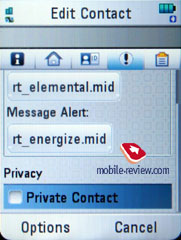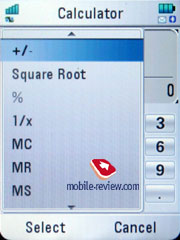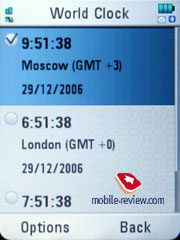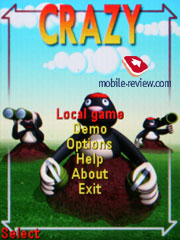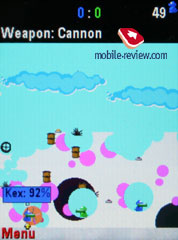|
|
Review of GSM-handset Motorola Z6
Sales package:
- Handset
- Charger
- Li-Ion battery
- User Guide
- miniUSB data cable
- Wired stereo-headset
- microSD memory card (size varies by region)
Motorola Z6 is the second Motorola-branded slider, and generally, was not meant to exist. Actually, we should thank for this release the obscure state of affairs in the field of new products development, as having bet on creation of a new software/hardware platform, Motorola has fallen flat. As a result, early in 2006 the avalanche of problems has started growing and the range was expanded mainly with copycats of aged devices, especially the RAZR. Relying on the designer solutions, over at the company they were making hasty attempts to make up for the time they had lost by tailoring already existing offerings. Specifically, they re-initiated the UIQ project, previously these were third-generation devices and the company tried to relocate some handsets from the Chinese market to Europe. In China, while this market is unlike all other countries, Motorola has a substantial representation and thus is able to define development of models for this particular market, form the range. Such touchscreen-equipped solutions as Motorola MING, ROKR E6 and other offerings running on eZx Linux platform have proven to be a success. In the meantime, another Linux-based platform saw the release of the ROKR E2, which positively impressed me, as the model was far ahead of its time, a true revolution. However the inability of the company to attune it to the European market, carry out “field tests” and localize the offering has spelt the death of this model everywhere but in China. Unofficially, though, it is still available in a number of countries, but its hefty price tag and missing localization are not the best things about it. That solution is a milestone, make no mistake about that, but the complexity of the processes going on over at Motorola had not given us a flicker of hope that it would get a successor. Only the crisis served as powerful spur to the advent of a Motorola ROKR E2 replica, housed in a different form-factor and sporting different capabilities. The second Motorola-branded slider has turned out to be a mix of the ROKR E2 and other devices.
Video, handset (mpg, 14.7 Mb)>>>





Putting Motorola RIZR and the Z6 side be side you’ll see that they are actually twins. As for the design there are no differences at all, only the rim of functional and numeric keys has changed a bit and metallic surface of the Z6 is coated in chrome, rather than in soft touch found on previous model. As if in an effort to emphasize the fact that shell is made of metal the company releases only one trim at the beginning, but more color schemes are to come, generally it will strongly depend on sales and popularity of the handset. For the time being the device comes in black as well. Such color causes certain associations, with the fashion-charged Nokia 8800, for example. It is strange, but looking at the photos one could barely notice a slightest similarity between them or even consider them as comparable. But in reality, a good half of fashionable people tended to compare this handset with Nokia 8800. At that, Nokia not always came out on top.


Measuring only 105x45x16.2 mm in size and weighing in at 107 grams (for the Z3 – 106x46x16 mm, 108 grams), the Z6 readily slips in any pocket without bringing about any discomfort or something even worse. Key lock may be turned on automatically, preventing the function keys from being accidentally pressed. The handset utilizes a traditional RAZR-style keypad – if there are still some people among our readers not familiar with it, we shall describe it as a metal plate with engraved keys captions. The four-way navigation key has OK button inserted into it. As for the numeric keypad, it can be revealed only by sliding the handset open and shows off bulky buttons with good and, more importantly, noticeable click sensation. The slope of the casing is a unique solution overlooked by other companies – thanks to this feature you won’t experience any problems with reaching both the top and the bottom key rows, even people with really big hands won’t end up hitting the slider’s upper part. The keys are evenly lit in blue, which is well-visible in various conditions.









The slider is armed with auto-opening mechanism, making the process of sliding the Z6 open single-handedly a breeze. The area beneath the screen houses a comfortable thumb-rest, adding some points to the overall convenience of the phone. This is how we described the opening mechanism of the Z3 but in the Z6 the manufacturer has managed to make the slider action even softer, the halves move apart with ease. In terms of slider action the model is more preferable.




Should we go on comparing the two models, the Z6 has an obvious advantage thanks to its screen. The display is the same as that of the ROKR E2 which is in fact one of best matrixes around. It has Sharp matrix which now has become a synonym to quality of handsets’ screens. With 2 inch diagonal the display has QVGA-resolution (240x320 pixels, 31x41 mm, 262 K colors). As for the Z3’s screen, with 1.9 inch diagonal its resolution is 176x20 pixels. Incidentally, you can see the difference on the face-off photos, who comes out the winner here, I suppose, will be obvious to you.



By default the screen brightness is set on 3, but there are 6 grades available. On the first level the screen falls dark so the brightness switch may be called five-leveled. On the top level brightness is really superfluous: eyes get tired after having long usage sessions with the Z6, the picture gets too sharp and crisp. On the contrary, the default settings are quite comfortable to work with.
Thanks to high screen sharpness it has become possible to use various fonts; by the way much of the credit here goes to the OS as well. The display can hold up to 6 lines while in the phonebook view mode, the font is bulky and easy to read, in addition there is a service line above, and captions to the soft-keys at the bottom. While reading SMS messages the screen accommodates 8 lines, in this case the font becomes smaller but remains perfectly legible. But you will fully enjoy everything the screen has to offer only when working with Opera-mini at minimal font size – if that’s the case, display houses 26 text lines and two service lines. At that the text is legible enough and for reading news site such style is quite fitting. Naturally, it is difficult to work in this mode for a long time.
Status line showing currently active features, Bluetooth for example, is displayed in all menu items. The thumbnails are quite tiny, yet you will have no hard time understanding what is what there.
In the sun screen does well, picture is well-visible and text remains readable – using the Z6 in these conditions was never an issue.
We didn’t compare the screen with those of other up-to-date models, as for the time being this matrix is one of the market’s best proposals; on top of that there hasn’t been any major technological breakthrough lately. If you are eager to face off the display against its rivals, I strongly recommend that you look at the photos in the review of Motorola ROKR E2 as in that article we paid much attention to this matter.


The left side retains the volume rocker switch, and a bit lower – Smart-key. The user is at liberty to customize it and assign it to Camera app or something else. While navigating through the menus, this key may double as OK-button or act in a different way, depending on given menu item. On the right one will find Voice Command key standing for voice dialing, voice commands in a standby mode and sound recorder activation during a call. MiniUSB slot for plugging in charger or headset is also embedded in the side plate. Dedicated camera key is also placed here.



On the handset’s back you can see the loudspeaker’s grill at the bottom, which steps onto the scene when it comes to playing back ring tones or hands free mode. Apart from that, 2 Mpix camera’s lens and a flash module take up the top of that handset’s rear, making it look different from the KRZR.
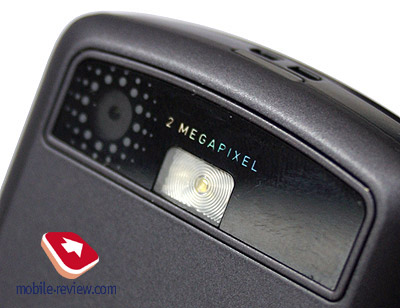
The battery cover is made of metal and doesn’t expose even the slightest hint of gap, unlike the faceplate the back is made of soft touch plastic. The slot for microSD memory cards is placed between this cover and the SIM-card bed, meaning that you can seamlessly swap memory cards even on a working device.

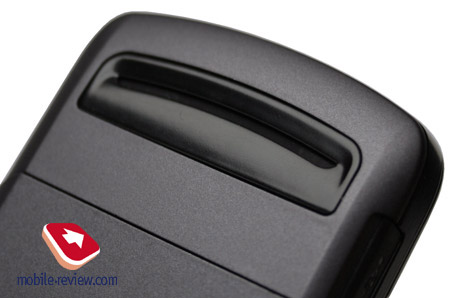

The Z6 carries a 700 mAh Li-Ion battery, BC50, onboard (like in the Z3 more capacious cells are not available for this model). As the manufacturer claims, it can keep the handset up and running for up to 200 hours and 2.5 hours in standby and talk modes respectively. In the conditions of Moscow networks, the device lasted for 2 days on average at 1 hour of calls, 1 hour of music playback and up to 20 minutes of other functions usage. Batteries boasting higher capacity are not available for this model. On the whole, it wouldn’t be right to expect something more than two days of lifetime – this figure is pretty much OK for most users. It takes the phone two hours to charge from empty to full.

Used more intensively than the Z3, the device works for two days, which is an admirable result. In terms of battery life we should put the Z6 face-to-face with smartphones rather than ordinary handsets – he does away with the former providing almost two times longer lifetime. Average battery life put up by smartphones sporting identical functionality makes up about a day. You don’t have to be a rocket scientist to see the benefits of Linux here.
Before moving on to interface, I’d like to say a few words about the hardware platform used in this solution. The company officials have constantly emphasized that this phone is the speediest Motorola’s Linux-based solution, and improves upon the ROKR E2 in terms of performance. And it is really interesting to know why that is so?
The Z6 runs on Linux by MontaVista, kernel version 2.6.10 (in previous models 2.4.20 was used), but it does not have negative influence on the model’s speed. The device’s circuit technique has been changed, as for the first time the company has applied Freescale SCMA-11 CPU running at 628 MHz (for comparison’s sake, the E2 houses 208 MHz CPU). It would seem that such high rate should make the phone more power-hungry but nothing like that has actually happened, as probably it is a single-chip solution (i.MX31 by Freescale). One might easily get confused here, but, for example the ROKR E2 has in fact 3 chips, while the number of CPUs in the Z6 has been cut down to two. It gives it a boost in performance and reduces energy consumption of the handset. Basing on my own experience, I’d like to say that by default the device “falls asleep” pretty past, it will take about a second to bring it out of this state.
Menu
Video, menu (mpg, 88.8 Mb)>>>
At a glance, the Z6 should be an exact replica of ROKR E2, and it actually seems to be, after having a glimpse of the handset. In reality, though, the differences are many, but while some of them are substantial, the others aren’t so flashy and have almost no impact on the image of the phone. Let us take a closer look at the features the Z6 brings to the table, and traditionally we begin with the user interface.
At the standby screen there can be up to 4 shortcuts, that can be removed from the screen should you wish to do so. The left soft-key is bound to Options item, which is in fact a sort of fast start menu, specifically the list features key lock, camera application, message creation, profile change, offline mode, alarm clock and finally, standby screen setup (digital or analogue clock, shortcuts management) options.
Navigating through the handset’s menu is as simple as it only could be – to enter any menu press the joystick, to go one level back use “C” key (with an arrow etched on it).
The main menu can be viewed either as a 3x3 grid or a list. Shortcut number navigation is enabled in the Z6. On the plus side, the device keeps in memory which menu item you called up last, thus when entering the main menu, it automatically highlights it. In the sub-menus, however, the item highlighted is the one on the list’s top – apart from Motorola, today only Samsung has come up with implementation of this feature, but the in the latter case sub-menus have this option enabled as well.
For all items found in the main and sub- menus, you can modify their order of appearance, own applications can be tossed within different folders. The user is also at liberty to create own folders in the main menu and assign icons and names to them. This option is just great and simply a winner thanks to plain and uncomplicated implementation.
The negative things about any local version of the Z6, though, include captions to the menu items – being too long they don’t fit into the screen, so that once you highlight any item scrolling steps into action, but the impressions aren’t particularly favorable. For example, at a glimpse you see Web Ac…, Office T…, Muktime.., File Ma… and so on. Why they couldn’t think of shorter captions – I do not know. That strange “Web Ac..” would be better off with “Web” caption. Other items could use some name-changing as well, and it wouldn’t be that hard at all.
Voice functions. On the right spine is a dedicated key enabling you to access the voice functions. In the standby mode it is responsible for number dialing or entering the commands. The Z6 comes included with speaker-independent voice recognition system. It does not require prior voice training; the handset identifies majority of commands without any problems. Particularly, it is possible to a dial the number from the phonebook, it is enough to say the first name and the last name, and then specify number type – office, home, fax, etc. The list of the commands is quite lengthy: from voice dialing to activation of some menus or checking battery status and signal strength (check battery, check status). The function is quite fetching and sometimes comes in handy, especially when using the headset. Pressing the headset button in the standby mode is similar to the voice key action. In other words, one can manage the handset without taking it in hands.
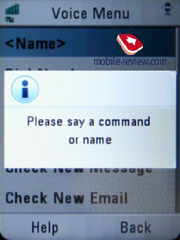 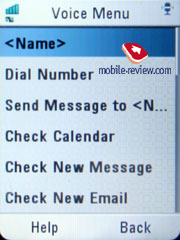
The similar system of voice dialing is found in the up-to-date models by Motorola; but this function is not newsworthy for being offbeat, until you see its integration with the Talking phone. In the Settings for some menu items you can make the handset read out their titles.
Imagine that you have received a message. Apart from the message alert, the handset is capable to read out the number of sender, his/her first name and the last name if there are any. On opening the message, the handset starts reading out its contents. In some cases when the handset is right in front of you, this function is pretty much useless; but while driving a car, jogging or doing something like that it can come in handy. English texts are read out by a mail voice quite acceptably; one can catch the sense of that has been said with ease. Unfortunately, it is difficult for the handset to read phone numbers; as the Z6 tries to interpret them as numbers, thus in verbal presentation of seven-digit numbers there are millions, thousands and so on, which is confusing. Naturally, the handset does not recognize any abbreviations; it reads them out letter by letter, and that brings about some problems. It is possible to set up the virtual reader for messages, e-mail, received calls (i.e., it reads out the name of the caller when receiving a call), menu items (when navigating through the menu the selected item is read out; doesn’t work for third-level sub-menus). Finally, while navigating through the contacts list in the phonebook, entries can be read out too, just like the numbers when dialing on the keypad, though. If you dial numbers too fast, the function can miss some of them, but luckily it can be switched off. It is good to known, that the settings for voice communication are different for every item; the user can set them in any desirable fashion. In terms of voice functions the Z6 is still one of the market’s most fetching offerings, just like ROKR E2 was a year ago.
Text input, personal dictionary. The process pf handling text input with this model is a result of development of intelligent iTap system. Specifically, while “word guessing” is on, automatic filling-in and the most probable word combinations are offered, which allows you not to punch in entire words. This function works well and makes for fast texting.. The words the phone does not know are memorized automatically after the first input and offered along with the combinations from the dictionary. At the same time the user can put his/her own words in the dictionary forcibly. For security sake the dictionary can be activated only after entering password (password input is required in the Settings menu on activation, you have to do it only once, though protecting it with a password is not a must).
When typing in text, up to 5 input modes can be used, to swap between them press # key. Pressing the # repeatedly allows going through all available modes. The user chooses their order of appearance, for example, intelligent text input is on top of the list, followed by letter-by-letter, etc. It is important, that automatic word filling-in works also when typing in letter after letter - it makes texting so much easier. While using letter-by-letter input mode, if the symbol assigned to the same key is required, you will have to use the cursor to remove highlighting from the previously entered symbol, and if you don’t do that, then it will simply disappear. This also happens once you have finished typing in text and moved to another field: the last entered symbol gets highlighted and then disappears from the display. While this bug is frustrating, all you can do is adapt to it. The story repeats when pressing “Send” button in messages – the highlighted symbol vanishes from the screen.
Multitasking. The handset fully lives up to the bar set by the modern phones in terms of this aspect; while playing back music in the background mode you can work with other applications as well. The good thing about the phone is that it keeps in memory the state of standard functions you left them in, if you closed them using the hang up button rather than « Ñ ». For instance, while typing a message you can press the hang up key, activate the Messages menu from the main menu – and you are back to the message creation screen, on top of that the text you have typed a few moments ago will not vanish.
Back on the minus side, the Z6 lacks task/memory manager, thus you end up being unable to check what applications are currently running and if needed switch between them.
Phonebook. While creating a new contact you have access to five tabs featuring various fields. The first one is used for inputting First name, Last name and also up to 4 phone numbers (pick from 5 types - mobile, office, home, fax, other). The selection of types is so limited due to the speaker-independent voice recognition system found on the handset. For one entry it is possible to submit two e-mail addresses and to choose their type. Finally, in this tab one can put the Instant Messaging number; which can be the ICQ number, for instance.
The last item here is selection of the caller group – by default the handset houses 4 groups, however you can create unlimited amount of groups (not less than 20) and customize them with personal image, ring tone, tune for SMS (any file).
The second tab retains address field, where you can put postal address, city, state, postal code, address type. The handset supports up to two fully filled-in addresses.
The third tab is a personal photo or picture of a contact. On incoming call the assigned picture takes up almost the entire screen’s real estate.
The fourth tab enables choosing ring tone and messages notification for a contact, which have higher priority over those of a group. The Privacy item is of some interest: by checking it, you protect the entry from being copied to PC, while it will be still visible in the general list. You are also at liberty to activate the phone guard, and then accessing the phonebook is only possible after entering the password.
The fifth tab contains extra information, for instance, text or voice notes. It is possible to put in your manager's name, the assistant's name, URL, nickname, Spouse, manage "Children" field. Birthday allows setting a notification and selecting time span (from one day to two weeks prior to the event). The Anniversary field works in a similar fashion and allows setting up a reminder as well.
In the general list entries are shown only as first and list names and number type icon standing on the right. Side scrolling allows switching between all numbers for any specific name. Search by first name or last name search can be initiated. You can sort the contacts list in real time as well (either by first name or last name).
In the thumbnail view mode, apart from the first and last names the handset presents you with the default number.
You can select either SIM-card; phone and SIM-card or only phone for contacts storage purposes. Using the third option is more preferable, though. The Z6 enables you to copy all entries onto SIM-card.
As for extra features, we can’t overlook the ability to create an own namecard, which is a stand-alone menu item. Compared to the ROKR E2, handling of the general list is now much speedier – in my case, the list consists of 400 or so entries, at that I had almost instant response to first-letter search.
The unique function of the phonebook is Most Frequent Contacts option. In the general list it is enough to activate this view mode to sort the contacts list. All the contacts that you looked through recently will be put on top of the list, while below you will find a standard list with the rest of the names available. This feature comes in handy for those who have more than 300 contacts in their books. Sorting contacts by e-mail addresses and groups works pretty much in the same way. A big advantage of the Z6 is the fact that groups in the phonebook seamlessly synchronize with MS Outlook.
In addition to the groups, you are enabled to draw up mailing list, both for text messages and e-mails. Over and above, every list can belong to a particular category of contacts or be a stand-alone item. A list can contain up to 100 addresses, meaning that those keen on this very functionality will be more than happy with the Z6.
On the whole the implementation of the system of filters is convenient to manage, you can switch between SIM-card only view, sort by e-mail addresses and also Most Frequent Contacts. Unfortunately, it can be done only from the context menu, * and # keys are out of work here, as pressing them initiates a search.
Synchronization with PC does not cause any hardships; all fields get identified and sorted out properly. Moreover, receiving a phonebook from another device via Bluetooth is also a cinch, even though you can retrieve only text information, while text and tunes can’t be transferred.
In the general list one can mark either an individual note or a couple at a time. All of them can be transferred to another device via Bluetooth (bulk mailing of all entries is not supported). The interesting thing is the ability to lock some contacts, so they won’t get deleted on synchronization (you have enabled contacts replacement option), or from editing contacts by malevolent persons.
The handset supports remote synchronization of the phonebook with Exchange ActiveSync server. It is enough to set type of synchronization and handset mode and enter server settings. Overall the phone book can store not less than 1000 entries with fully filled-in fields.
The phonebook implementation in handset is close to perfect. It combines the plenty of fields, very flexible settings and filters. Being an undisputable winner among up-to-date Motorola-branded offerings in terms of ease of use, the Z6 can’t cope with the contact information system in Symbian (where the number of fields is unlimited), but it easily trumps it with ease of input, provides more intuitive layout. Those who feel the necessity to submit more than 4 numbers for a single contact should look elsewhere. But really, no one has got such a need except for students and extremely small number of businessmen whose share make up nearly 2–3 percent of all users.
Messages. The number of messages stored in the handset depends on the volume of the free memory, but in practice it proves to be nearly unlimited – when I was writing this review, I had about 800 messages stockpiled in the memory after a month of usage. This model has the standard structure of folders, enabling you to create own folders. Next to each folder are the number of messages stored in it and the number of unread messages. While looking through the list of every folder this data is also shown on top of the screen.
 
 
 
 
 

The process of handing SMS/MSS messages is unified as much as only it’s possible. When creating a message you cannot see any difference between those two types of messages (Nokia has come to this solution for its S60-powered Symbian-smartphone only recently, first products with this feature onboard are due out in the second half-year). But should you paste video or photo in the text, and the “SMS” will instantly turn into “MMS” in the service line (message type can be forcibly changed). It is quite logical, though this feature is designed mainly for unsophisticated users, just like the handset itself.
While texting you can see number of symbols entered in the service line above. Support for EMS is onboard, however there are no smiles or pictures prepared exclusively for this standard available. You can make use of the default templates, they are divided into two groups: for SMS and MMS respectively. For text messages there are delivery report and reading confirmation at your disposal, as well as message priority settings.If a message couldn’t be delivered instantly, for example you were out of the coverage, then the Z6 will postpone sending automatically, so unlike other phones, here you should not worry that your message won’t reach the recipient. However this seemingly handy feature occasionally causes some incidents – for instance, I was completely out of luck once, being unable to send a message for almost 20 hours (the handset was turned off or out of the coverage). And when it actually made its way to the recipient’s phone, it was already too late (really, how could we possibly meet when my plane had already taken off).
The volume of an MMS message is not capped - in our case the handset delivered easily a 2 Mb message. The handset houses Postcard MMS template – in fact it is an MMS, meant for printing, on reception. As a rule it is designed as a postcard: picture on the front and text on the rear. The good things about the MMS-message here include scheduled sending, on set date and time.
Mail client can handle POP3/IMAP/SMTP-servers, it is possible to create and setup several profiles. Message size is unlimited (the biggest message we retrieved was about 8 Mb), all types of attachments are supported (reading and loading don’t bring any problems at all, since the handset saves everything “as is”). Setting up your mail, you can enabled scheduled mail check, allow the handset to retrieve the entire message, headline only first 1, 5, 10 KB of it.
 
 
 
What I like about the mail client is the ability to receive mail on launching the application and send all letters on shutting it down. You can disable notification of new letters (matches the icon for ordinary messages). Attachments in the form of html-files are opened in Opera 8.5, which comes pre-installed with the phone. This approach ensures best possible page viewing experience. All attached files are viewed in the list form, enabling you to pick particular files. The handset readily deals with any encodings, including the Russian ones, hence all letters we couldn’t read with UIQ or S60 based smartphones are a cinch to read on the Z6. I received about 500 letters a day and they all were crammed into the single list. Such huge amount of mail made the handset freeze for a few seconds every time I was attempting to open it, but then it enabled navigation through the list.
Out of the ordinary aspects include the fact that your letters don’t get erased when deleted from the server (for example via your home PC). The manufacturer believes that the mail you have uploaded is of primary importance and it should be up to you to decide what to do with it. While this approach makes some sense, it proves to be different from other platforms and solutions available today, nevertheless it only takes some getting used to, and you will be good to go.
We must admit that the email management system found on the Z6 is very apt; the only thing it lacks is Push Mail, while for the rest it easily matches almost any smartphone. Generally, mailing is one of the best things about the handset.
Office tools. This menu combines several functions, specifically organizer, to-do list, notes, calculator, file manager, download manager, world clock and MOTOSYNC. Your mail boxes can be accessed from this menu as well. Let’s start off with the organizer.
Calendar. Traditionally there are three view modes – monthly, weekly and daily. In the monthly view (set by default) you se events for particular days, showed as stripes. While in weekly view, the screen is filled up with a sort of timetable and you can easily check how busy you will be in course of a day. Hence, the daily view is not much different. In the settings it is possible to enable tasks-only chronologized view. The user can choose which type of the calendar will be displayed by default. All in all there are loads of settings to pick from, for example you are enabled to choose week start day, week length (5, 6 or 7 days). You can also set pitch for the time grid (from 30 minutes to 3 hours), as well the time when your day stars and ends for weekly or daily view. On the face of it, there is nothing special about all these settings, yet they allow for precise tuning of the organizer, so that it would perfectly fit your schedule.
 
 
 
 
 
 
 
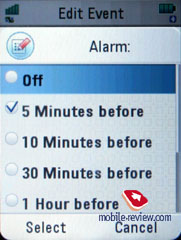 
 
 
New events in the calendar are entered in the same way as new contacts in the phonebook, which means there are four tabs at your disposal. Using the first one you can select event type (12 different types, from dinner or breakfast to conferences, flights and vacation), on top of that each type has an own icon in the general list, which makes it really exciting to view. The following fields are available: event name, location, full-day event (can be ticked), profile activated on the event’s start (by default – current profile). Among other things you can set start and end time for an event and alert (from 1 minute to 1 week prior to the event) And if you don’t like the pre-installed time spans, you can make up your own (from 1 to 90 minutes long). Alert tune can be taken from the current profile or set up individually for every event.
The second tab contains a text note for the event.
The third tab is truly unique due to allowing you to list event participants. For instance, you can type in the name of organizer and his postal address (by default it is your address); in the next field you can put the names of attendees of the presentation or some other type of event. Having picked their e-mail addresses from the phonebook and entered them manually, you can forward details on the meeting outright. The time of the event can be shown as free, busy, out of office or extremely important. Another customizable option - the event may be personal, private, and confidential. Basically, this option, as well as the security settings, defines the place of a particular event in the general list.
The fourth tab allows adjusting repeat mode, with the following types available: daily, weekly, monthly, and yearly. Once you have decided on the type, you are allowed to manage extra parameters, like the number of weeks the event will occur in (every x weeks, i.e. every second week, for instance, if you have entered 2). There is also a duration limit, meaning that you can just set the date when the event will stop being repeated. For weekly repeat setup you may choose a particular day, which the event takes place on, and that’s really handy for some appointments. The repeat settings offered by the Z6 will satisfy even the most demanding users – that’s for sure. The developers believe that viewing repeated events in the monthly view is not vital, so that you are able to check repeated even for a week or a day, which actually makes some sense.
Synchronization with PC runs smoothly, data can be beamed either from the phone or onto it. The separate events in the form of vCard notes can be sent to other devices via Bluetooth. The already existing events can be rescheduled for other days; all you have to do is enter the new date.
To-do list. These notes are very simple: you just enter the name, the end date (if needed), status (finished task), priority (normal, high, low), at last, text note. Unlike the organizer, there is no reminder feature available, and this is logical, as these are tasks at hand, rather than scheduled events. Hence, it is not possible to copy a task into the organizer, due to them being incompatible.
It is possible to set sorting by the end time in the general list, task status (finished or not). To-do notes can be sent to other devices with SMS messages or via Bluetooth.
Notes. This app allows you to enter basic text notes with the following options available – flagging entries in the general list, sending notes to other devices via Bluetooth or SMS messages. The file extension for notes employed by the handset is not .txt, but this is the extension in which they are sent to other devices.
Calculator is quite basic and works just fine.
World clock function is implemented in a very fetching fashion – apart from the map which is a must-have for any application of this kind, you can compare current time in up to three cities.
MOTOSYNC. There is so-called Exchange ActiveSync which allows for distant data synchronization for organizer, phonebook and also mail program. There are also SyncML settings, it doesn’t take long to master them.
File manager. The file system of the phone is closed, thus you will have to deal with the default layout. Specifically, My files folder contains Pictures, Videos, Voice Note, Application Downloads, My Blog, Music and Sounds, Unrecognizable Files (in this folder there are all files which were not recognized by the handset, but can be beamed anywhere), My Documents, Contact Images (caller IDs) , Memory Card (access to memory card).
There is no such term as joint memory in the handset, thus the memory card acts as separate storage meant mainly for music, photos than for any other files. In many respects this is why the Z6 comes installed with multimedia files search and index updating system. While this solution makes some sense, it will look unusual to most users, so it will take them some time getting used to it.
In My Documents there are some folders available, as well as links to web pages and messages of IM-manager.
Any folder can be viewed as a list, detailed list, or thumbnails. Stand-alone files (or you can pick the ones you need) can be copied to memory card, copying folders (function SendTo) is also supported. Lists can be sorted by name, date, size.
Another thing of note is that txt-files have an own icon, and on top of that, while in list-with-preview mode, you are presented with the first line of a file. In other words, the Z6 can seamlessly handle txt files. What is more the same goes for pdf-files and MS Office documents, yet for the time being this features blocked.
The speed of copying data onto the memory card is very high, you will barely find any niggles here. When copying separate files it is not possible to select destination folder, so that they will be put into the root directory of the card. It is not particularly convenient.
The handset carries about 70 Mb or user-manageable memory, you can check volume of free memory from the main menu by calling up the context menu. It is really good to know that space used is categorized by type – you can always see how much memory particular application or section takes up. This volume is quite enough for storing caller IDs, ring tones and messages tunes (even though these can be saved on the memory card).
The file manager found on the Z6 aims to appeal to unsophisticated users, which doesn’t go well with the handset’s functionality. The guideline that it builds on is very simple: limit the user by minimizing the number of enabled interactions with user-data. On the other hand, taking into account the possibility of working with the memory card on PC there is no dire need in a file manager. The ability to create folders and sub-folders on the handset is quite popular and will be appreciated by the users.
We truly liked the file manager due to its being stable and bug-less work.
Download manager. It is a very pleasant application which is integrated with browser and allows file downloading in the delayed mode. To put it in plain English, when clicking on a link, it gets transferred to this application and put onto the list of downloads. It is possible to minimize the current downloads. Then you can look through the list and the result of download or activate downloading if the file was not received. On the second tab you will see files transferred via Bluetooth. You can execute/open any file from any list. The simplicity of the application is its advantage, when you feel the need in the large amount of downloads this app becomes a must-have.
Alarm clock. You can set up any number of alarms, for any of them it is possible to set personal tune (by default taken from the profile) and repeat mode (Monday ~ Friday, weekends, daily). The general option for all alarms is Snooze Time, specified in minutes, by default its value makes up 5 minutes.
 
 

Music player. This model has adopted its music department from the ROKR E2, and it would seem that its musical merits should be beyond question. However they are and at the same time are not. For reasons unknown, radio has gone missing on the Z6, on top of that miniUSB is the sole socket on the handset’s casing, while the bundled stereo-headset is somewhat crude, if loud. But there is always anther way, in this very case it may be original Motorola-branded miniUSB-3,5mm adapter for 20 USD. Nevertheless the sonic experience with own headphones plugged-in will be great, the volume put up by the phone will prove to be lower than expected (which is strange, since neither RAZR MAxx V6 nor other offerings have this effect). It is a shame, but our experiments showed that maximum volume could be achieved only with a handful of headphones – bluntly speaking, the model that could have pretended to the crown of one of the market’s best offerings, is now down as one-among-crowd. At present the company is trying to rectify that, we have already filed an official request on this issue.
 
 
 
 
Opening the player application reveals the following options: Playlists, Recently Played, Albums, Artists, Genres, Composers. You can choose any of them, depending on what you need. Basically these are sort of filters for files stored on your phone. Want to listen to some hip-hop? Then go to Genres section, and so on. Information is retrieved from ID 3 tags of mp3 files.
There's absolute freedom in creating playlists, you can choose several songs, or only a particular tracks during the playback. There aren't any limits in adding files, it doesn't matter if a file is located on the memory card or in the phone's internal memory. Playlists can be copied, renamed and saved again. You can choose certain songs from one playlist and copy it to another. All lists can be sorted according to your taste. The phone supports such modes as shuffle, intro (5 seconds from the beginning of each song).
As you remember the ROKR E2 had equalizers onboard, however they have forgone them in the Z6. There's only Spatial Audio option in the menu (virtualization of sound source, there aren't any counterparts of this in mobile phones or mp3 players, this feature is unique). A very basic and poor analogue of Spatial Audio is Stereo Widening technology used in Nokia- and Sony Ericsson-branded products. Since we believe in the justice for all, it will be fair to say that Spatial Audio was first introduced in Motorola E1000, but that model didn't become a big hit among the consumers, which didn’t make for the popularity of this technology either.
Spatial Audio technology makes the sound volumetric; it actually gives every song a sort of depth, which was unheard before. Unfortunately it's still not perfect, you will notice slight defects when this feature is turned full blast (listening to music at maximum level (7) was impossible for my ears even in noisy locations). You can try experimenting with the settings of Spatial Audio (7 bars) in order to find the best option for you. Using Spatial Audio for Soul and Reggae is a must, the sound becomes really juicy and clean. This is also a way to raise the volume of output signal, it becomes noticeably louder.
Bass Boost is here to stay for all those who love this function, once again there are 7 grades for setting up, switching between them will present you with notable changes in sounding.
Handling the player is very easy, you can skip tracks by pressing the navigation pad, engage rewind and fast forward by pushing it left or right. Pressing the navigational pad up or down will start or end playback. Side-keys are used for same purposes. The rewind is progressive. There is also support for Album Art – in playback mode it is displayed as a tiny thumbnail, yet you can enjoy its full-screen version as well.
When player is minimized you can work with the rest of phone's features and functions, meanwhile when the display is in standby mode you will see track title and its current position in the playlist on-screen. In order to maximize the player – just press joystick upwards. The phone supports A2DP profile, which allows sending sound to any stereo Bluetooth-headset. No problem were spotted with doing that, everything worked nicely. The player can be easily managed via the headset as well, however the phone doesn’t sport the ability to transfer track title to the headset.
The Z6 has multimedia search option, which can be used for music files too. The phone looks for song titles, allows detailing search by genre. As for photos, it's easier here, you search only for filename.
Support for Mp3 files exposes no defects or something we could complain about, this phone is good at playing high bit rates and deals with VBR. The Z6 is capable of handling the most complicated tracks because of high interface speed between memory card and the device itself.
Short resume on mp3 implementation is rather simple: the phone comes in well-equipped, managing the player itself is a breeze, and side-keys make it so much easier to interact with. As for the sound quality, subjectively it is one of the best on the market, but the volume level is somewhat insufficient.
The player supports following music formats:
- RA v10
- AMR NB
- XMF
- AMR WB
- AAC
- WMA v9, v10, v11
- AAC+ Enhanced
- AAC+
- MP3
Games. The Z6 comes pre-loaded with two games – Crazy and Sudoku.
Voice Recorder. The Voice Recorder works in both stand by and talk modes. You can choose the default file name and memory type, in which the file will be saved. The length of the record is not limited by anything but the free space on memory card. During our tests, we managed to record a 40-minute phone call without any problems. Recorded voice memos can be used as ring tones as well.
Opera 8.5 is the default browser for the Z6, sporting cookie support, ability to fit viewed pages into the screen (and also full-screen mode), font settings, dynamic scaling, Javascript and loads of other options to choose from or adjust. The browser handles Russian encodings with ease – if we are to face off Opera 8.5 against other company’s offerings, then it will turn out that the Z6 is the true powerhouse in this respect. Basically, it is one of the market’s best browsers, partly yielding only to Nokia Web Browser (OSS Browser version 2).
 
 
 
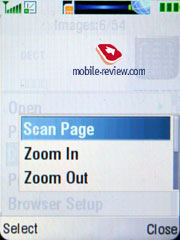 
 

Settings. There are 8 default profiles, and the user can customize them as well as create his/her own. There are a lot of profile settings to choose from, we will list only the main ones: ring type (ring tone only, ring tone and silent alert, silent alert followed by ring tone). Volume can be adjusted for ring tones, service tones and mp3 player. Alerts can be set up for all standard applications: contacts, events, organizer, email, IM, alarm clock. Finally, the phone has offline mode during which the network part of the phone will be disabled, meanwhile other features will remain available.
Themes – there's a certain difference from the triplets, the main menu icons don’t change as you switch between themes, but you can do it on your own. Instead of that themes can change window appearance, color schemes; there are three themes preinstalled.
Connections. Since there's no Infrared port, Bluetooth is the only way to communicate with outside world. Bluetooth manager is presented in a very interesting way, as it consists of two tabs. On the first one you see the list of devices that our phone has interacted with, even if they are currently not bounded to it. On the second bookmark you can search for all available devices. It's possible to use a more specific search: phones, headsets, PCs, PDAs, printers. The phone becomes visible for only 3 minutes, this time span is something we have come to expect for Motorola's products.
The phone has a comprehensive selection of profiles onboard, including A2DP, as well as the ability to print on the Bluetooth-compatible printers. The version of Bluetooth is 1.2. Ability to view file system of other devices (GET method) has been disabled due to certain ideological reasons, whereas the ROKR E2 featured such option before.
That's not all, more surprises are on their way. When you are sending file to another device, through context menu you will see the same Bluetooth manager, but next to devices list you will see checkboxes. Have you already guessed why we need them? In case you have not, here's the answer to the riddle: you can send one file to several devices at once. And actually this feature is quite handy, especially when everybody wants to get a hold of your brand new ring tone. But it's better to be precise, the file will not be sent simultaneously to all devices, this operation will be done step by step, through the download manager.
Modem. Modem settings on wireless or USB connection, setup of automatic modem launch is present too.
Data connections. Here you can use either wap-protocol or internet APN. The settings are quite simple, there's nothing complicated about them.
USB-connectivity. The manufacturer claims that the Z6 has support for USB High Speed 2.0 standard and while in USB Mass Storage or MTP modes the miniUSB connection indeed delivers data transfer speed of 1100-1250 Kb/s, meaning that copying a 75 Mb big album takes less than one minute, which is pretty good for the today’s device and on top of that one of the market’s best speeds. On USB connection in one of the abovementioned modes, you get all phone-related functions blocked, which leaves you the only option of working with PC, however you are still able to receive calls, as the network part doesn’t get disabled.
Settings menu contains several types of PC connection: Media Sync (MTP protocol), Memory Card (driver-less USB Mass Storage), Tools (synchronization with Mobile Phone Tools), Modem&Tools (synchronization and operation as a modem).
The good thing here is full-fledge support for Windows Media Player 11, allowing you to create playlists on PC and then move them onto the handset. In future support for this player will spread over all Motorola-branded devices.
Phone settings – the categories in this menu are uncomplicated and thus easy to understand. In phone settings you can alter display parameters, time and date, language, input language, see battery's level in % (more detailed way than simple battery icon), switch on energy saving mode. The phone supports firmware updates over the air, there's corresponding option in the menu list. Some interesting settings: it is possible to disable voice dialing when pressing button on the headset, disable or enable automatic answering.
Security – the phone has standard phone lock, it can be used only when the phone gets turned on or at any moment you like. It is also possible to set password on Messages, Calendar and Contacts menus, so that without entering the password these applications will simply refuse to launch.
Call list and other phone functions. There are three lists with 20 entries in each available. Same numbers don’t get merged, they remain separate entries. The phone displays first name and last name of the contact together with the number type icon. In the general list (fourth on the list) you will see 20 last entries from three other lists. You will see what kind of call it was with the help of thumbnails. In case you are interested in details, you can check date and time of the call, as well as its length. You can switch between the lists by pressing * or #.
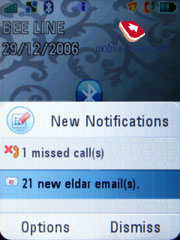 
On incoming call the photo takes up quite big part of the display, contact's name or his/her phone number are displayed too. When a message is received you will see the sender's phone number in case it's not present in the contact book. You can activate Sound Recorder flicking on side-key during a call, you can also send sound to Bluetooth headset and make other standard actions. During the call there's a timer ticking, so that at the end of the call you will be shown its duration.
Frequently used numbers are displayed not only in the phonebook, but when creating new messages and email too. This is extremely convenient, allows saving some time.
Java. Heap size for applications is 2 Mb, there's no limitation for JAR-file size. You can install java applications via wap or directly from other devices. The applications can be stored on the memory card or in the handset’s memory – it makes no difference. The applications can work minimized, this means that JIMM (ICQ client) can be used with great deal of comfort. It is possible to setup custom security settings for each application. Unfortunately you cannot override annoying security issues (except for the applications with available security certificate), which are pretty much similar to the ones in Sony Ericsson's devices. However the Z6 doesn’t present you with the ability to run two applications simultaneously – you can either minimize or close an application.
Camera. The handset is armed with a 2 Mpix CMOS-powered matrix, matching other offerings by the company specs-wise. At the same time, the settings are somewhat different – while maintaining the same 3 compression levels, the Z6 features four resolutions available to user:
- 1200x1600;
- 768x1024;
- 480x640;
- 120x160;
You are enabled to choose default picture name, storage place, the very unique feature is automatic forwarding of snaps to pre-set addresses (only via MMS messages, all shots get scaled automatically). Even though the broad audience might not feel the dire need in such option, I’m most positive there will be people who will grow fond of this function.
The default LED, while shooting in the dark, is of no real use, yet occasionally it does come in handy. Digital zoon (x8) and multi-shot mode come included with the Z6 as well. As for overlays, we can’t miss the following available effects - Black&White, Antique, Negative, Reddish, Greenish, Bluish. Date and time stamp and be put on every snap automatically.
 |
 |
(+)
maximize, 1200x1600, JPEG |
(+)
maximize, 1200x1600, JPEG |
 |
 |
(+)
maximize, 1200x1600, JPEG |
(+)
maximize, 1200x1600, JPEG |
 |
 |
(+)
maximize, 1200x1600, JPEG |
(+)
maximize, 1200x1600, JPEG |
 |
 |
(+)
maximize, 1200x1600, JPEG |
(+)
maximize, 1200x1600, JPEG |
 |
 |
(+)
maximize, 1200x1600, JPEG |
(+)
maximize, 1200x1600, JPEG |
 |
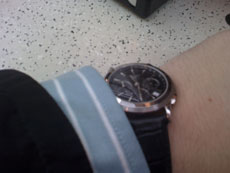 |
(+)
maximize, 1200x1600, JPEG |
(+)
maximize, 1200x1600, JPEG |
The handset records video in 176x144 pixel resolution with unlimited clip duration. All in all the quality of video clips captured with the Z6 doesn’t live up to the bar set for today’s mobile solutions, yet it proves to be inferior not to every last competitor – frequently vendors consider camera capabilities superfluous.
Sample video 1 (3gp, 285 Kb)>>>
Sample video 2 (3gp, 509 Kb)>>>
Sample video 3 (3gp, 270 Kb)>>>
Performance. Thanks to the CPU running at 628 MHz, the handset passed our performance tests with flying colors. Below you can find its results placed face-to-face with those put up by the ROKR E2.
| Motorola Z6 Jbenchmark 1 |
Motorola ROKR E2 Jbenchmark 1 |
| Date |
225.02.2007 |
| Model name |
moto z6 |
| Firmware version |
r1jc002 |
|
|
| Jbenchmark 1 |
1.1.1 |
|
|
| Version |
|
|
|
| Total Score: |
12079 |
|
|
| Details: |
|
| Text |
3237 |
| 2D Shapes |
3216 |
| 3D Shapes |
1783 |
| Fill Rate |
1202 |
| Animation |
2641 |
|
|
| Screen Width |
240 |
| Screen Height |
246 |
| Color Screen |
true |
| Number of Colors |
262144 |
| Double Buffer |
true |
| Total Memory |
1048576 |
| Free Memory |
532304 |
|
|
| MicroEdition Configuration |
CLDC-1.1 |
| MicroEdition Profiles: |
MIDP-2.0 |
| Microedition Platform: |
j2me |
| Microedition Encoding: |
ISO-8859-1 |
| Microedition Locale |
en-GB |
|
| Date |
|
| Model name |
|
| Firmware version |
|
|
|
| Jbenchmark 1 |
1.1.1 |
|
|
| Version |
|
|
|
| Total Score: |
7177 |
|
|
| Details: |
|
| Text |
1835 |
| 2D Shapes |
1950 |
| 3D Shapes |
1036 |
| Fill Rate |
621 |
| Animation |
1735 |
|
|
| Screen Width |
240 |
| Screen Height |
246 |
| Color Screen |
true |
| Number of Colors |
262144 |
| Double Buffer |
true |
| Total Memory |
1048576 |
| Free Memory |
532304 |
|
|
| MicroEdition Configuration |
CLDC-1.1 |
| MicroEdition Profiles: |
MIDP-2.0 |
| Microedition Platform: |
j2me |
| Microedition Encoding: |
ISO-8859-1 |
| Microedition Locale |
en-GB |
|
| Jbenchmark 2 |
Jbenchmark 2 |
| Version |
2.1.1 |
|
|
| Total Score: |
798 |
|
|
| Details: |
|
| Image Manipulation |
623 |
| Text |
1163 |
| Sprites |
666 |
| 3D Transform |
1060 |
| User Interface |
629 |
|
|
| Screen (canvas) Width |
240 |
| Screen (canvas) Height |
246 |
| Color Screen |
true |
| Number of Colors |
262144 |
| JPEG Support |
true |
| Transparency (Alpha Level) |
256 |
| Double Buffer |
true |
| Total Memory |
1048576 |
| Free Memory |
673924 |
|
|
| MicroEdition Configuration |
CLDC-1.1 |
| MicroEdition Profiles: |
MIDP 2.0 |
| Microedition Platform: |
j2me |
| Microedition Encoding: |
ISO-8859-1 |
| Microedition Locale |
en-GB |
|
| Version |
2.1.1 |
|
|
| Total Score: |
282 |
|
|
| Details: |
|
| Image Manipulation |
353 |
| Text |
808 |
| Sprites |
410 |
| 3D Transform |
691 |
| User Interface |
22 |
|
|
| Screen (canvas) Width |
240 |
| Screen (canvas) Height |
246 |
| Color Screen |
true |
| Number of Colors |
262144 |
| JPEG Support |
true |
| Transparency (Alpha Level) |
256 |
| Double Buffer |
true |
| Total Memory |
1048576 |
| Free Memory |
673924 |
|
|
| MicroEdition Configuration |
CLDC-1.1 |
| MicroEdition Profiles: |
MIDP 2.0 |
| Microedition Platform: |
j2me |
| Microedition Encoding: |
ISO-8859-1 |
| Microedition Locale |
en-GB |
|
| Jbenchmark 3D |
Jbenchmark 3D |
| Perfomance |
|
| Jbenchmark3D HQ: |
427 |
| Jbenchmark3D LQ: |
454 |
| Triangles ps: |
39841 |
| kTexes ps: |
3950 |
|
|
| version: |
3.1.0 |
|
|
| Screen(canvas)width: |
240 |
| Screen(canvas)height: |
320 |
|
|
| 3D Subsystem: |
|
| M3G Version: |
1.1 |
| Antialaising: |
false |
| True color: |
false |
| Dithering: |
false |
| Mipmapping: |
true |
| Perspective correction: |
true |
| Local camera lighting: |
true |
| Max lights: |
256 |
| Max Viewport dimensions: |
1024 |
| Max Texture Dimensions: |
256 |
| Max Sprite Crop Dimensions: |
1024 |
| Max Transforms Per Vertex: |
2 |
| Number of Texture Units: |
2 |
|
|
| Other properties |
|
| Color Screen |
true |
| Number of colors |
262144 |
| Transparency (alpha level) |
256 |
| Double buffer |
true |
| Total memory: |
1048576 |
| Free memory: |
494076 |
|
|
| MicroEdition Configuration |
CLDC-1.1 |
| MicroEdition Profiles: |
MIDP 2.0 |
| Microedition Platform: |
j2me |
| Microedition Encoding: |
ISO-8859-1 |
| Microedition Locale |
en |
| Microedition Communication ports: |
usb1 |
| Microedition Hostname: |
none |
|
| Perfomance |
|
| Jbenchmark3D HQ: |
2 |
| Jbenchmark3D LQ: |
213 |
| Triangles ps: |
24679 |
| kTexes ps: |
1973 |
|
|
| version: |
3.1.0 |
|
|
| Screen(canvas)width: |
240 |
| Screen(canvas)height: |
320 |
|
|
| 3D Subsystem: |
|
| M3G Version: |
1.1 |
| Antialaising: |
false |
| True color: |
false |
| Dithering: |
false |
| Mipmapping: |
true |
| Perspective correction: |
true |
| Local camera lighting: |
true |
| Max lights: |
256 |
| Max Viewport dimensions: |
1024 |
| Max Texture Dimensions: |
256 |
| Max Sprite Crop Dimensions: |
1024 |
| Max Transforms Per Vertex: |
2 |
| Number of Texture Units: |
2 |
|
|
| Other properties |
|
| Color Screen |
true |
| Number of colors |
262144 |
| Transparency (alpha level) |
256 |
| Double buffer |
true |
| Total memory: |
1048576 |
| Free memory: |
494076 |
|
|
| MicroEdition Configuration |
CLDC-1.1 |
| MicroEdition Profiles: |
MIDP 2.0 |
| Microedition Platform: |
j2me |
| Microedition Encoding: |
ISO-8859-1 |
| Microedition Locale |
en |
| Microedition Communication ports: |
usb1 |
| Microedition Hostname: |
none |
|
| Jbenchmark HD |
Jbenchmark HD |
| Version |
4.0.3 |
|
|
| Rendering Quality |
|
| Bilinear filtering: |
69% |
| Trilinear Filtering: |
Failed/Not supported |
| Perspective correction: |
Failrule (64%) |
| Z-buffer depth: |
16 bit or higher |
|
|
| Perfomance |
|
| Smooth triangles: |
105928 |
| Textured triangles: |
45574 |
| Fill rate: |
1723 kTexels |
| Gaming: |
40 (1.3 fps) |
|
|
|
|
| 3D Subsystem: |
|
| M3G Version: |
1.1 |
| Antialaising: |
false |
| True color: |
false |
| Dithering: |
false |
| Mipmapping: |
true |
| Perspective correction: |
true |
| Local camera lighting: |
false |
| Max lights: |
256 |
| Max Viewport dimensions: |
1024 |
| Max Texture Dimensions: |
1024 |
| Max Sprite Crop Dimensions: |
1024 |
| Max Transforms Per Vertex: |
2 |
| Number of Texture Units: |
2 |
|
|
| Other properties |
|
| Microedition Platform: |
j2me |
| Number of colors |
262144 |
| Transparency (alpha level) |
256 |
| Double buffer |
true |
|
|
|
|
|
|
| MicroEdition Configuration |
CLDC-1.1 |
| MicroEdition Profiles: |
MIDP 2.0 |
| CLDC (JSR 30, 139) |
1.1 |
| Encoding: |
ISO-8859-1 |
| Locale |
en |
| Total memory: |
1048576 |
| Free memory: |
610108 |
| MIDP (JSR 37, 118, 271) |
2 |
| Form width: |
240 |
| Form height: |
246 |
| Canvas Width: |
240 |
| Canvas Height: |
246 |
| Fullcanvas Width: |
240 |
| Fullcanvas Height: |
320 |
| Canvas doublebuffered: |
true |
| Color: |
true |
| Colors: |
262144 |
| Alpha levels: |
256 |
|
|
| FC (JSR 75) |
1 |
| PIM (JSR 75) |
1 |
|
|
| Bluetooth (JSR 82) |
no |
| Connected inquiry: |
|
| Connected inquiry scan: |
|
| Connected page: |
|
| Connected page scan: |
|
| Master switch: |
|
| Connected inquiry scan: |
|
|
|
| OBEX (JSR 82) |
|
| WMA (JSR 120, 205) |
2 |
| Smsc |
N/A |
|
|
| MMAPI (JSR 135) |
1.1 |
| Snapshots encodings: |
encoding=jpeg |
| Video capture: |
true |
| Video encodings: |
rgb565 480x320 |
| Streamable contents: |
none |
| Mixing: |
true |
| Recording: |
true |
| Audio encodings: |
pcm |
| Audio capture: |
true |
|
|
| Web Parser (JSR 172): |
1 |
| WEB RPC (JSR 172): |
1 |
| SATSA (JSR 177): |
1 |
| Location (JSR 179) |
1 |
| SIP (JSR 180): |
no |
|
|
| JTWI (JSR 185) |
1 |
| CHAPI (JSR 211): |
no |
| SVG (JSR 226): |
no |
| AMMS (JSR 234): |
no |
| Global (JSR 234): |
no |
|
| Version |
4.0.3 |
|
|
| Rendering Quality |
|
| Bilinear filtering: |
61% |
| Trilinear Filtering: |
Failed/Not supported |
| Perspective correction: |
Failrule (64%) |
| Z-buffer depth: |
16 bit or higher |
|
|
| Perfomance |
|
| Smooth triangles: |
52219 |
| Textured triangles: |
8456 |
| Fill rate: |
850 kTexels |
| Gaming: |
19 (0.6 fps) |
|
|
|
|
| 3D Subsystem: |
|
| M3G Version: |
1.1 |
| Antialaising: |
false |
| True color: |
false |
| Dithering: |
false |
| Mipmapping: |
true |
| Perspective correction: |
true |
| Local camera lighting: |
false |
| Max lights: |
256 |
| Max Viewport dimensions: |
1024 |
| Max Texture Dimensions: |
1024 |
| Max Sprite Crop Dimensions: |
1024 |
| Max Transforms Per Vertex: |
2 |
| Number of Texture Units: |
2 |
|
|
| Other properties |
|
| Microedition Platform: |
j2me |
| Number of colors |
262144 |
| Transparency (alpha level) |
256 |
| Double buffer |
true |
|
|
|
|
|
|
| MicroEdition Configuration |
CLDC-1.1 |
| MicroEdition Profiles: |
MIDP 2.0 |
| CLDC (JSR 30, 139) |
1.1 |
| Encoding: |
ISO-8859-1 |
| Locale |
en |
| Total memory: |
1048576 |
| Free memory: |
610108 |
| MIDP (JSR 37, 118, 271) |
2 |
| Form width: |
240 |
| Form height: |
246 |
| Canvas Width: |
240 |
| Canvas Height: |
246 |
| Fullcanvas Width: |
240 |
| Fullcanvas Height: |
320 |
| Canvas doublebuffered: |
true |
| Color: |
true |
| Colors: |
262144 |
| Alpha levels: |
256 |
|
|
| FC (JSR 75) |
1 |
| PIM (JSR 75) |
1 |
|
|
| Bluetooth (JSR 82) |
no |
| Connected inquiry: |
|
| Connected inquiry scan: |
|
| Connected page: |
|
| Connected page scan: |
|
| Master switch: |
|
| Connected inquiry scan: |
|
|
|
| OBEX (JSR 82) |
|
| WMA (JSR 120, 205) |
2 |
| Smsc |
N/A |
|
|
| MMAPI (JSR 135) |
1.1 |
| Snapshots encodings: |
encoding=jpeg |
| Video capture: |
true |
| Video encodings: |
rgb565 480x320 |
| Streamable contents: |
none |
| Mixing: |
true |
| Recording: |
true |
| Audio encodings: |
pcm |
| Audio capture: |
true |
|
|
| Web Parser (JSR 172): |
1 |
| WEB RPC (JSR 172): |
1 |
| SATSA (JSR 177): |
1 |
| Location (JSR 179) |
1 |
| SIP (JSR 180): |
no |
|
|
| JTWI (JSR 185) |
1 |
| CHAPI (JSR 211): |
no |
| SVG (JSR 226): |
no |
| AMMS (JSR 234): |
no |
| Global (JSR 234): |
no |
|
Impressions
The reception quality was never an issue with the Z6, as it is a typical solution from Motorola. The ring tones volume is average, while mp3 tunes sound a bit louder than that, guaranteeing that you will hear its alerts from just about anywhere, the silent alert is average or slightly above average strength-wise.
How stable are the model’s new software and hardware fillings? Many times better than already tweaked S60-powered products and pretty much on the same level with proven solutions among ordinary phones. Over our quality time with the handset we stumbled upon crashes a few times on incoming calls, PC synchronization (file transfer), and also the Z6 occasionally slowed down a bit when we had loads of mail. Overall the handset is quite reliable, errors or crashes are almost non-existent. An unsophisticated user will barely encounter any problems at all, since he/she is not likely to make use even of 10 percent of the handset’s true capabilities.
Back on the minus side, muffled sound outputted by the player when using custom headphones is not a good thing, as getting the right non-original earphone is quite challenging. The radio got left out because of a ridiculous prejudice that having it onboard Motorola Z6 might get to be a competitor to the ROKR E2 or ROKR E6, but to me, these solutions are so different, that even thinking of something like that is a pure absurd. The failures in marketing of this product are a different story altogether. Let’s start with the fact that a few hours into the official announcement of Motorola Z6 one could find radio on its spec sheet, it was removed later on, though. Up until now the press-release features a dedicated music key as one of the handset’s highlights, the manufacturer’s official page follows the suite.
In reality the handset sports a dedicated key for starting up the browser, while similarly to Motorola K3, the music button is missing, as the developers were short on time.. That is all about amusing inaccuracies in the official data available today.
The model occupies an intermediate spot between the camp of conventional phones and smartphones, swaying towards the former due to the form-factor and dimensions (similar smartphones only start making their ways to the market, for example, Nokia E65), and in the sense of functionality towards the latter camp. The handset shows off excellent design, materials used, spring mechanism, and what is more, its inners live up to that bar. The Z6’s display is actually one its type’s best offerings, at the same time camera falls short of this favorable image, being average specs-wise. But at the end of the day this comes as not surprise – cameras have always been Motorola’s weak spot.
Functionality-wise the Z6 is a step above any other offering available on the market these days, if we overlook smartphones, of course, but even faced off against them the handset doesn’t fall flat. Good performance and battery life are definitely the Z6’s strengths. The market hasn’t seen any counterparts in terms of sales package (speaking of the smartphones), phonebook, organizer, SMS-messaging and so on. The ideas first tested in the ROKR E2 were so far ahead of their time, that it is only now when other manufacturers are closing in on the bar set by Motorola, but they are not close enough yet. Among sliders, Motorola Z6 can rightfully lay a claim to the crown of “no-nonsense” category, being a very balanced solution. If oyu need a decent camera, then you should better look elsewhere outright, for example at Samsung-branded offerings, like Samsung D900, Samsung U600. Other devices lag behind the Z6 both in terms of functionality and price/quality ratio. On release, Motorola’s solution will retail for about 430-460 USD.
Calling Motorola Z6 a run-of-the-mill product wouldn’t make much sense – it is rather a milestone. A solution that gets in line with the ROKR E2, yet will maintain remarkable presence in Europe. Localization of the software has already been prepared – even though it is not brilliant or even of high quality, it does exist and can be dealt with. Bearing strong physical resemblance to Motorola Z3, the Z6 might give one a wrong impression that these two handsets are akin inside as well. Over a month of playing around with Motorola Z6, I encountered a very interesting phenomenon, when my friends or colleagues asked me to show them the Z6 and shortly after started calling me time after time, wondering when it was due out. For the time being, there are already seven people desperately waiting for this model. A thing of note is that even your humble servant will replace one of his main phones with Motorola Z6 – so appealing and charismatic this phone is. The Z6 arrives in the market in the end of March.
It would seem that after coming up with such a marvel, Motorola must do whatever it takes to house it any all form-factors and use this concept to its fullest. But I must dispel everyone’s illusions – this will never happen and Motorola Z6 will seemingly remain the only product boasting such hardware and software constituents. And the reason lies not in unawareness of the advantages of the platform or the deepest crisis over at the company. Basically, if we call this version of the product “6.3”, then “7.3” solutions are coming up – they will see release at the end of 2007, beginning of 2008 and trump competitors with deep integration of NVidia’s graphics acceleratorwith the interface, allowing for a fundamentally new 3D user interface and games, high CPU speed (single-chip solution by Freescale). And up until then, within the company’s range and, well, on the market, Motorola Z6 will remain the most feature-packed offering. Take a note, that a year will pass before it gives this title up, meaning that the Z6 can have rightful claims on the award of 2007’s best slider. Now it is all up to Motorola, let us hope it won’t come up with something like what it did to the ROKR E2. Only the maker himself can bury such a successful product. I really want to believe this won’t be the case.
Eldar Murtazin ([email protected])
Translated by Vera Paderina; Oleg Kononosov ([email protected])
Published — 27 February 2007
Have something to add?! Write us... [email protected]
|
News:
[ 31-07 16:21 ]Sir Jony Ive: Apple Isn't In It For The Money
[ 31-07 13:34 ]Video: Nokia Designer Interviews
[ 31-07 13:10 ]RIM To Layoff 3,000 More Employees
[ 30-07 20:59 ]Video: iPhone 5 Housing Shown Off
[ 30-07 19:12 ]Android Fortunes Decline In U.S.
[ 25-07 16:18 ]Why Apple Is Suing Samsung?
[ 25-07 15:53 ]A Few Choice Quotes About Apple ... By Samsung
[ 23-07 20:25 ]Russian iOS Hacker Calls It A Day
[ 23-07 17:40 ]Video: It's Still Not Out, But Galaxy Note 10.1 Gets An Ad
[ 19-07 19:10 ]Another Loss For Nokia: $1 Billion Down In Q2
[ 19-07 17:22 ]British Judge Orders Apple To Run Ads Saying Samsung Did Not Copy Them
[ 19-07 16:57 ]iPhone 5 To Feature Nano-SIM Cards
[ 18-07 14:20 ]What The iPad Could Have Looked Like ...
[ 18-07 13:25 ]App Store Hack Is Still Going Strong Despite Apple's Best Efforts
[ 13-07 12:34 ]Infographic: The (Hypothetical) Sale Of RIM
[ 13-07 11:10 ]Video: iPhone Hacker Makes In-App Purchases Free
[ 12-07 19:50 ]iPhone 5 Images Leak Again
[ 12-07 17:51 ]Android Takes 50%+ Of U.S. And Europe
[ 11-07 16:02 ]Apple Involved In 60% Of Patent Suits
[ 11-07 13:14 ]Video: Kindle Fire Gets A Jelly Bean
Subscribe
|

















































